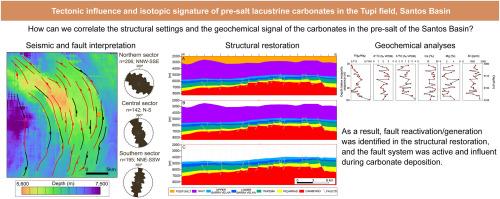桑托斯盆地图皮油田盐下湖相碳酸盐岩的构造影响及同位素特征
IF 1.5
4区 地球科学
Q3 GEOSCIENCES, MULTIDISCIPLINARY
引用次数: 0
摘要
桑托斯盆地的断裂网络对巴拉维拉组沉积的沉积环境条件起着关键的控制作用。本文结合地震解释、构造恢复和主要元素(Ca、Mg、Sr、Fe、Mn)和同位素(δ13C、δ18O、87Sr/86Sr)的地球化学分析,研究了断层活动和再活化如何影响盐下碳酸盐和元素分布。结果表明,伊拉济马地区具有NNW-SSE、N-S、NNE-SSW 3个主要断裂组,剖面恢复显示伊拉济马地区中部有明显的变形。研究井δ13C(0.79‰~ 3.16‰)和δ18O(- 1.22‰~ 3.86‰)同位素数据与盆地其他油田一致,反映了区域控制战胜了局部构造对沉积的影响。然而,湖相沉积环境以幕式环境变化来描述,铁和锰存在极端异常值,断裂可能影响流体运移中的锶动员。87Sr/86Sr值(0.7130 ~ 0.7144)表明长英质陆源占主导地位,少量火山输入。这些发现强化了断裂对图皮油田盐下碳酸盐岩元素运移和构造演化的控制作用。本文章由计算机程序翻译,如有差异,请以英文原文为准。

Tectonic influence and isotopic signature of pre-salt lacustrine carbonates in the Tupi field, Santos Basin
Fault networks in the Santos Basin play a key role in controlling depositional environmental conditions for sedimentation of the Barra Velha Formation. This work investigates how fault activity and reactivation affect the pre-salt carbonates and influence element distribution, integrating seismic interpretation, structural restoration and geochemical analyses for major elements (Ca, Mg, Sr, Fe, Mn) and isotopes (δ13C, δ18O, 87Sr/86Sr). Results reveal three dominant fault sets (NNW-SSE, N-S, NNE-SSW), with significant deformation in the central sector of the Iracema region indicated by section restoration. Isotopic data of δ13C (0.79 ‰–3.16 ‰) and δ18O (−1.22 ‰–3.86 ‰) from the studied well are consistent with other fields in the basin, which reflects that regional control overcomes local tectonic impact on deposition. However, the lacustrine depositional setting is described with episodic environmental changes as Fe and Mn present extreme outlier values and faults may influence Sr mobilization in fluid migration. The 87Sr/86Sr values (0.7130–0.7144) suggest a dominant felsic continental source, with minor volcanic input. These findings reinforce the role of faulting in controlling element mobility and the structural evolution of pre-salt carbonates in the Tupi field.
求助全文
通过发布文献求助,成功后即可免费获取论文全文。
去求助
来源期刊

Journal of South American Earth Sciences
地学-地球科学综合
CiteScore
3.70
自引率
22.20%
发文量
364
审稿时长
6-12 weeks
期刊介绍:
Papers must have a regional appeal and should present work of more than local significance. Research papers dealing with the regional geology of South American cratons and mobile belts, within the following research fields:
-Economic geology, metallogenesis and hydrocarbon genesis and reservoirs.
-Geophysics, geochemistry, volcanology, igneous and metamorphic petrology.
-Tectonics, neo- and seismotectonics and geodynamic modeling.
-Geomorphology, geological hazards, environmental geology, climate change in America and Antarctica, and soil research.
-Stratigraphy, sedimentology, structure and basin evolution.
-Paleontology, paleoecology, paleoclimatology and Quaternary geology.
New developments in already established regional projects and new initiatives dealing with the geology of the continent will be summarized and presented on a regular basis. Short notes, discussions, book reviews and conference and workshop reports will also be included when relevant.
 求助内容:
求助内容: 应助结果提醒方式:
应助结果提醒方式:


